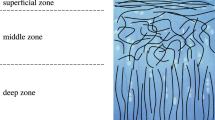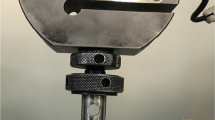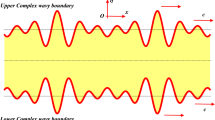Abstract
Under suitable conditions, the motion of a fluid in a porous medium can be studied by assuming the validity of Darcy’s law. Since many biological tissues can be thought of as porous media, Darcy’s law is invoked in several biomechanical contexts, like the transport of the chemical species needed for the metabolism of tissue cells. Although Darcy’s law supplies physically sound results in many circumstances, there may be cases in which the dynamic behaviour of a biological fluid deviates from the Darcian one. The scope of this work is to analyse some possible consequences of such deviations, with emphasis on the fluid velocity and pressure, which, in turn, influence the health and correct functioning of the tissue cells. In particular, our study addresses the flow of an interstitial fluid through a fibre-reinforced tissue, in which the fibres are oriented statistically. We take articular cartilage as a representative tissue of this type, and study the deviation from Darcy’s law known as “Forchheimer’s correction”. Moreover, we introduce two models of tissue permeability, which lead to discrepant results when the fluid velocity is described by Darcy’s law. We show, however, that the discrepancies in the description of the flow can be reduced if Forchheimer’s correction is applied.









Similar content being viewed by others
References
Ateshian GA, Weiss JA (2010) Anisotropic hydraulic permeability under finite deformation. J Biomech Eng 132:111,004–1–111,004–7
Athanasiou KA, Darling EM, Hu JC (2009) Articular cartilage tissue engineering. Synth Lect Tissue Eng 1:1–182
Athanasiou KA, Rosenwasser MP, Buckwalter JA, Malinin TI, Mow VC (1991) Interspecies comparisons of in situ intrinsic mechanical properties of distal femoral cartilage. J Orthop Res 9:330–340
Bear J, Bachmat Y (1990) Introduction to modeling of transport phenomena in porous media. Kluwer, Dordrecht
Bennethum LS, Giorgi T (1997) Generalized Forchheimer equation for two-phase flow based on hybrid mixture theory. Transp Porous Media 26:261–275
Bennethum LS, Murad MA, Cushman JH (2000) Macroscale thermodynamics and the chemical potential for swelling porous media. Transp Porous Media 39:187–225
Bishop RL, Goldberg SI (1968) Tensor analysis on manifolds. Prentice-Hall, Englewood Cliffs
Byrne H, Preziosi L (2003) Modelling solid tumour growth using the theory of mixtures. Math Med Biol 20:341–366
Carfagna M, Grillo A The spherical design algorithm in the numerical simulation of biological tissues with statistical fibre-reinforcement. Comput Visual Sci 1–28. doi:10.1007/s00791-017-0278-6
Chen SS, Falcovitz YH, Schneiderman R, Maroudas A, Sah RL (2001) Depth-dependent compressive properties of normal aged human femoral head articular cartilage: relationship to fixed charge density. Osteoarthr Cartil 9:561–569
Federico S, Gasser TC (2010) Non-linear elasticity of biological tissues with statistical fibre orientation. J R Soc Interface 7:955–966
Federico S, Grillo A (2012) Elasticity and permeability of porous fibre-reinforced materials under large deformations. Mech Mater 44:58–71
Federico S, Grillo A, La Rosa G, Giaquinta G, Herzog W (2005) A transversely isotropic, transversely homogeneous microstructural-statistical model of articular cartilage. J Biomech 38:2008–2018
Federico S, Herzog W (2008) On the anisotropy and inhomogeneity of permeability in articular cartilage. Biomech Model Mechanobiol 7:367–378
Federico S, Herzog W (2008) On the permeability of fibre-reinforced porous materials. Int J Solids Struct 45:2160–2172
Grillo A, Carfagna M, Federico S (2014) The Darcy-Forchheimer law for modelling fluid flow in biological tissues. Theor Appl Mech TEOPM7 41(4):283–322
Grillo A, Guaily A, Giverso C, Federico S (2015) Non-linear model for compression tests on articular cartilage. J Biomech Eng 137:071,004–1–071,004–8
Grillo A, Logashenko D, Stichel S, Wittum G (2012) Forchheimer’s correction in modelling flow and transport in fractured porous media. Comput Vis Sci 15:169–190
Hardin RH, Sloane NJA (1996) McLaren’s improved snub cube and other new spherical designs in three dimensions. Discret Comput Geom 15:429–441
Hassanizadeh SM (1986) Derivation of basic equations of mass transport in porous media. Part 2. Generalized Darcys and Ficks laws. Adv Water Resour 9:208–222
Hassanizadeh SM, Gray WG (1979) General conservation equations for multi-phase systems: 1. Averaging procedure. Adv Water Resour 2:131–144
Hassanizadeh SM, Gray WG (1979) General conservation equations for multi-phase systems: 2. Mass, momenta, energy, and entropy equations. Adv Water Resour 2:191–203
Hassanizadeh SM, Lejinse A (1995) A non-linear theory of high-concentration-gradient dispersion in porous media. Adv Water Resour 18(4):203–215
Hedlund H, Mengarellli-Widholm S, Reinholt F, Svensson O (1993) Stereological studies on collagen in bovine articular cartilage. Acta Pathol Microbiol Immunol Scand 101:133–140
Holmes MH (1986) Finite deformation of soft tissue: analysis of a mixture model in uniaxial compression. J Biomech Eng 108:372–381
Holmes MH, Mow VC (1990) The nonlinear characteristics of soft gels and hydrated connective tissues in ultrafiltration. J Biomech 23:1145–1156
Khaled A, Vafai K (2003) The role of porous media in modeling flow and heat transfer in biological tissues. Int J Heat Mass Transf 46:4989–5003
Li D, Engler TW (2001) Literature review on correlations of the non-darcy coefficient. In: Proceedings of the SPE permian basin oil and gas recovery conference, Midland, Texas, 15–17 May 2001
Liu IS (1982) On representations of anisotropic invariants. Int J Eng Sci 20(10):1099–1109
Mak AF, Lai WM, Mow VC (1987) Biphasic indentation of articular cartilage—I. theoretical analysis. J Biomech 20:703–714
Maroudas A, Bullough P (1968) Permeability of articular cartilage. Nature 219:1260–1261
Marsden JE, Hughes TJR (1983) Mathematical foundations of elasticity. Dover Publications Inc, New York
McLaughlin R (1977) A study of the differential scheme for the composite materials. Int J Eng Sci 15:237–244
Mow VC, Holmes MH, Lai MW (1984) Fluid transport and mechanical properties of articular cartilage: a review. J Biomech 17:377–394
Mow VC, Kuei SC, Lai WM, Armstrong C (1980) Biphasic creep and stress relaxation of articular cartilage in compression: theory and experiments. J Biomech Eng 102:73–84
Norris AN (1985) A differential scheme for the effective moduli of composites. Mech Mater 4:1–16
Pierce DM, Ricken T, Holzapfel GA (2013) A hyperelastic biphasic fibre-reinforced model of articular cartilage considering distributed collagen fibre orientations: continuum basis, computational aspects and applications. Comput Methods Biomech Eng 16:1344–1361
Pierce DM, Ricken T, Holzapfel GA (2013) Modeling sample/patient-specific structural and diffusional responses of cartilage using dt-mri. Int J Numer Methods Biomed Eng 29:807–821
Podzniakov S, Tsang CF (2000) A self-consistent approach for calculating the effective hydraulic conductivity of a binary, heterogeneous medium. Water Resour Res 40:1–13
Quiligotti S (2002) On bulk mechanics of solid-fluid mixtures: kinematics and invariance requirements. Theor Appl Mech 28:1–11
Quiligotti S, Maugin GA, dell’Isola F (2003) An eshelbian approach to the nonlinear mechanics of constrained solid-fluid mixtures. Acta Mech 160:45–60
Quinn TM, Dierick P, Grodzinsky AJ (2001) Glycosaminoglycan network geometry may contribute to anisotropic hydraulic permeability in cartilage under compression. J Biomech 34(11):1483–1490
Rivlin RS, Ericksen JL (1955) Stress-deformation relations for isotropic materilas. J Rational Mech Anal 4:323–425
Spencer AJM (1984) Constitutive theory for strongly anisotropic solids. In: A.J.M. Spencer (ed.) Continuum theory of the mechanics of fibre-reinforced composites, pp 1–32. Springer, Wien, Austria (1984). CISM courses and lectures no. 282, international centre for mechanical sciences
Stracuzzi A (2015) Stime dell’influenza della correzione di Forchheimer nei modelli bifasici della cartilagine articolare. M.Sc. Thesis, Politecnico di Torino (In Italian)
Thauvin F, Mohanty KK (1998) Network modeling of non-darcy flow through porous media. Transp Porous Media 31:19–37
Tomic A, Grillo A, Federico S (2014) Poroelastic materials reinforced by statistically oriented fibres—numerical implementation and application to articular cartilage. IMA J Appl Math 79:1027–1059
Torzilli PA, Mow VC (1976) On the fundamental fluid transport mechanisms through normal and pathological articular cartilage during function—I the formulation. J Biomech 9:541–552
Torzilli PA, Mow VC (1976) On the fundamental fluid transport mechanisms through normal and pathological articular cartilage during function—II the analysis, solution and conclusions. J Biomech 9:587–606
Walpole LJ (1981) Elastic behavior of composite materials: theoretical foundations. Adv Appl Mech 21:169–242
Walpole LJ (1984) Fourth-rank tensors of the thirty-two crystal classes: multiplication tables. Proc R Soc Lond Ser A 391:149–179
Wang X, Thauvin F, Mohanty KK (1999) Non-darcy flow though anisotropic porous media. Chem Eng Sci 54:1859–1869
Whitaker S (1996) The forchheimer equation: a theoretical development. Transp Porous Media 25:27–61
Wu JZ, Herzog W (2000) Finite element simulation of location- and time-dependent mechanical behavior of chondrocytes in unconfined compression tests. Ann Biomed Eng 28:318–330
Acknowledgements
This work has been supported in part by the Politecnico di Torino (Italy) [AG] and [MC], in part by the Fondazione Cassa di Risparmio di Torino (Italy), through the “La Ricerca dei Talenti” (“HR Excellence in Research”) programme [AG] and in part by the Natural Science and Engineering Research Council of Canada, through the NSERC Discovery Programme [SF]. Finally, we would like to acknowledge the contribution of Mr. Alberto Stracuzzi (former student of the Politecnico di Torino) to the material contained in Sect. 5.1 [45].
Author information
Authors and Affiliations
Corresponding author
Ethics declarations
Conflict of interest
The authors declare that they have no conflict of interest.
Additional information
In memory of our master Prof. Gaetano Giaquinta (1945–2016).
Rights and permissions
About this article
Cite this article
Grillo, A., Carfagna, M. & Federico, S. Non-Darcian flow in fibre-reinforced biological tissues. Meccanica 52, 3299–3320 (2017). https://doi.org/10.1007/s11012-017-0679-0
Received:
Accepted:
Published:
Issue Date:
DOI: https://doi.org/10.1007/s11012-017-0679-0




